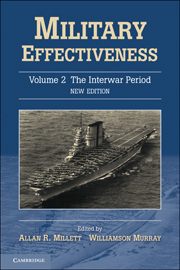Book contents
- Frontmatter
- Contents
- List of Contributors
- Introduction: Military Effectiveness Twenty Years After
- Maps
- 1 The Soviet Armed Forces in the Interwar Period
- 2 The French Armed Forces, 1918–40
- 3 The Military Effectiveness of the US Armed Forces, 1919–39
- 4 The British Armed Forces, 1918–39
- 5 Japanese Military Effectiveness: The Interwar Period
- 6 The Italian Armed Forces, 1918–40
- 7 German Military Effectiveness between 1919 and 1939
- 8 Military Effectiveness of Armed Forces in the Interwar Period, 1919–41: A Review
- Index
6 - The Italian Armed Forces, 1918–40
Published online by Cambridge University Press: 05 June 2012
- Frontmatter
- Contents
- List of Contributors
- Introduction: Military Effectiveness Twenty Years After
- Maps
- 1 The Soviet Armed Forces in the Interwar Period
- 2 The French Armed Forces, 1918–40
- 3 The Military Effectiveness of the US Armed Forces, 1919–39
- 4 The British Armed Forces, 1918–39
- 5 Japanese Military Effectiveness: The Interwar Period
- 6 The Italian Armed Forces, 1918–40
- 7 German Military Effectiveness between 1919 and 1939
- 8 Military Effectiveness of Armed Forces in the Interwar Period, 1919–41: A Review
- Index
Summary
Introduction
The disastrous performance of the Italian armed forces in the Second World War cannot be fully understood without reference to the development of military institutions in the interwar period. Five factors had a major impact on Italian military efficiency in the years between 1918 and 1940: the uneasy relationship between the political authorities and the armed forces leadership, Italy's limited resources, the lack of a central command organization, Italian engagement in continuous military operations from the summer of 1935 onward, and MussoliniU's personal alliance with Hitler.
The attempt by the Liberal governments of 1918–22 to impose direct civilian control over the armed forces for the first time in Italian history helped promote the military-Fascist alliance of 1922. In return for standing aside during the March on Rome, Mussolini promised the military leadership unprecedented autonomy. At the same time, many of the more dynamic members of the military came to view fascism as the means to modernize Italian society and the armed forces. These differing appeals to both traditionalist and progressive elements within the military leadership gained the benevolent neutrality of the armed forces toward the Fascist coup.
Once in power, however, Mussolini strove to bring the military under the complete domination of the government. Although Mussolini never succeeded completely, he established substantial control over the armed forces by 1940; but the political struggle which resulted produced a fissure within the military between a Monarchist-conservative and a Fascist-innovator block.
- Type
- Chapter
- Information
- Military Effectiveness , pp. 169 - 217Publisher: Cambridge University PressPrint publication year: 2010



